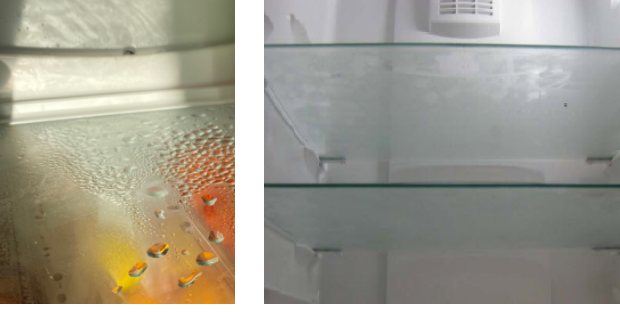Issue
- Moisture on the glass shelves in the fridge
- Drops of water under the glass bottom
- Drops of water under the freezer
- Condensate water below the glass shelf
Image 1: Examples of water droplets under the glass shelf
Applies to
- Fridges
- Fridge-freezers
Resolution
The cooling appliances themselves cannot form moisture. Moisture always comes into the appliance through food or air humidity.
How to prevent/minimize condensation inside the fridge:
- To reduce humidity and avoid the consequent formation of frost, always store liquids in sealed containers in the refrigerator. Frost tends to concentrate in the coldest parts of the evaporating liquid and, in time, your appliance will require more frequent defrosting.
- Never place warm food in the refrigerator. Warm food should be allowed to cool at room temperature and should be arranged to ensure adequate air circulation in the refrigerator compartment.
- Cover the food or wrap it appropriately.
- Always open the door as briefly as necessary.
- Check the door seal to see if it is compressed or deformed in one place.
- To bring the seal back into shape, gently heat it up with a hairdryer and pull it into shape.
- Note: After changing the door hinge, it may happen that the seal no longer fits properly on the housing.
Cause
- For example, if you store a lot of vegetables, such as green lettuce, in the refrigerator, the humidity in the refrigerator increases and more water droplets form, especially under the glass cover of the vegetable compartment.
- Fogging of the glass shelves is normal and cannot be prevented, especially when there is high humidity in the room where the device is installed. This occurs mainly in the warm summer months.